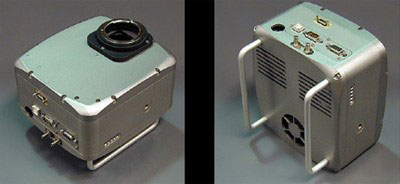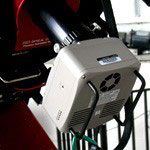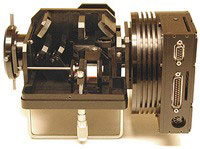Radford University
Telescope and Instruments
RCOS 14.5" Telescope
The centerpiece and workhorse of the observatory is the 14.5" RCOS telescope. In addition, there are a variety of components — some to extend its viewing capabilities, some to collect data, and some to control its various functions.
The telescope is a 14.5" f/9 Ritchey-Chrétien telescope built by RC Optical Systems.
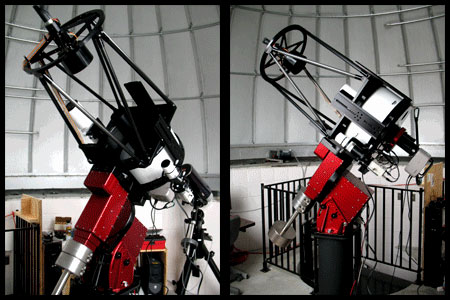
The telescope has a focal ratio of f/9, a mirror diameter of 368 mm (14.5"), and a focal length of 3315 mm (130"). Our theoretical angular resolution is 0.31 arcseconds of separation.
The magnification and field of view (FOV) depends upon the attached eyepiece.
Eyepiece |
Magnification |
FOV |
| 31mm | x107 | 46 arcmin |
| 20mm | x166 | 30 arcmin |
| 12mm | x276 | 18 arcmin |
For comparison, the angular size of the Moon is about 30 arcmin (or ½°).
Ritchey-Chrétien Telescope (RCT)
The Ritchey-Chrétien telescope (or RCT) is a specialized Cassegrain telescope designed to eliminate coma, thus providing a relatively large field of view as compared to a more conventional configuration. An RCT has a hyperbolic primary and a hyperbolic secondary mirror. It was invented in the early 1910s by American astronomer George Willis Ritchey and French astronomer Henri Chrétien.
The Ritchey-Chrétien design is free of third-order coma and spherical aberration. When focused midway between the sagittal and tangential focusing planes, stars are imaged as circles, making the RCT well suited for wide field and photographic observations. As with the other Cassegrain-configuration reflectors, the RCT has a very short optical tube assembly and compact design for a given focal length. The RCT offers good off-axis optical performance, but examples are relatively rare due to the high cost of hyperbolic primary mirror fabrication; Ritchey-Chrétien configurations are most commonly found on high-performance professional telescopes.
The 2.4m Hubble Space Telescope is an RCT.
Borg 101mm Wide Field Imager
f/6.4; focal length 646mm
With SLR cameras
Several T-mount adapters allow us to attach SLR cameras to the telescopes. The Borg 101 ED offers a wide field of view (though we can also use the large telescope). See the Photography page for more information.
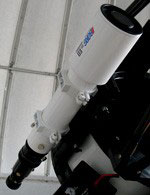
With Eyepieces
Eyepiece |
Magnification |
FOV |
| 31mm | x21 | 3.9º |
| 20mm | x32 | 2.5º |
| 12mm | x54 | 1.5º |
STL-11000M Camera
The camera is a large-format research-grade CCD with 4008 × 2672 active pixels (35mm film format, 11 megapixels) from Santa Barbara Instrument Groups.
The camera field of view is about 37 × 26 arcminutes. Its resolution is 0.56 arcsec/pixel. Given that local seeing is significantly worse than that (likely on the order of two arcseconds), we can recreate exactly images received by the telescope; see the Nyquist Sampling Theory for additional information.
Mallincam Video Camera
Mallincam Video Camera and Mini Borg 50mm Achromat Refractor
f/5; focal length 250mm; field of view is approximately 1.5° × 1°.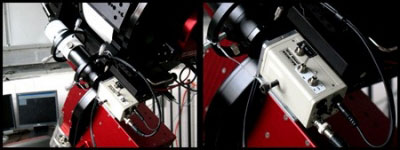
Self-Guiding Spectrograph
Computer Control
Telescope control is through a Dell desktop computer running Windows XP.
Alternative forms of control are available: the desktop computer can be replaced with a laptop or even a handheld device. Pointing can be done using an attached joystick, andfocusing can be controlled through a hand controller.
